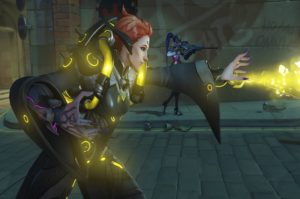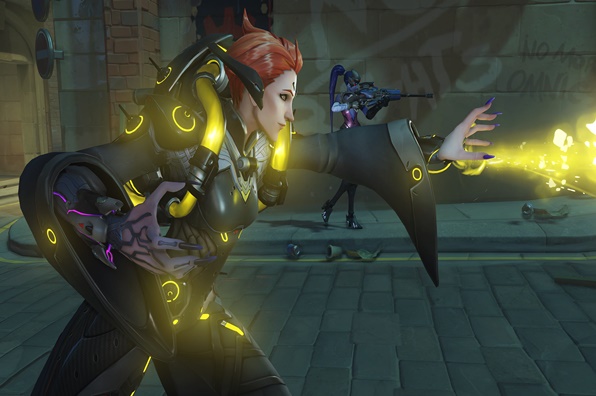Blizzard has a knack for launching unexpected surprises at their fan base, and at BlizzCon 2017, the Overwatch community received the surprise of a new hero in Moira. Amidst the Overwatch World Cup frenzy, the poignant nature of her character introduction and the fact she is a Talon (the “bad faction” in the Overwatch Universe) made her a perfect dichotomy to the Mercy meta pervading the incoming discussion. In fact, by some regard this was Blizzard’s ironic response to Mercy in both character lore and contrasting technical abilities. Although Moira is not yet launched as a public playable character, she may be in the coming days. So far, her time in the Public Test Realm (PTR) has established an aggressive, fast-paced, competitive, and intriguing strategy. Moira’s dark entry into the Overwatch Universe provides a competitive light to shape new fundamentals in the esports meta over the coming weeks and months.
Overwatch Hero Moira – Dark Casting Light onto the Esports Scene
Overview
Heading into BlizzCon 2017, one of the reigning discussion points was the desire for a new support character. Not because the support cast was dull – Zenyatta, Lucio, etcetera all provide their own opportune strategy – rather, support mains desired a fresh, unique combination to develop. To drive the request even more specifically, the desires was for a support member from the Talon faction who was overtly dark.
Both requests were not only fulfilled, but blown away with the introduction of Moira. Biotic abilities grant her a diverse play style, while providing a fundamental contrast to any other support hero. One moment Moira will be healing teams like a guardian angel, the next she will be using biotic orbs of terror to strike fear into the heart of the opponent.
Abilities begin and end with flexibility, granted by either biotic grasp or biotic orbs. Biotic grasp from her left hand is a bright-beam of hope used to heal. For nine seconds, she will restore 80 health per second up to 15 meters away. The agile nature of the biotic grasp makes it a witty healing technique. However, her biotic abilities also make her intrinsically aggressive; after time, she runs out of biotic grasp and can only restore healing ability by attacking.
Her right-hand beam might as well be a death ray for sucking the life and hope out of the opposing team. By using this ability, she heals herself, sucks life from the enemy (50 damage per second) and replenishes her left-hand healing bar. The juxtaposition of the two biotic grasps contain intriguing strategic implications; the player must balance when and how they position themselves against the opposing team. She cannot simply remain behind tanks as deep-line support, but must take an unprecedent aggressive support role.
However, her other ability, biotic orb, creates true versatility in play style, creating a ball of either health or death. Thus, at one moment she can launch an orb that drains health from enemies targeted (50 DPS, 200 maximum), then the next she can transition to healing team mates at 75 health per second (300 maximum). The tethering may be short range at five meters, but that plays directly into the more poignant attack line adjusted toward.
Blizzard added in a powerful cooldown ability in the form of Fade, a short teleportation transition which grants her invincibility. Fade plays directly into front-line support her biotic abilities encourage. Should the user get stuck in a sudden bamboozle with teammates dropping on an attempted flank, fade allows for a quick retreat option.
The ultimate granted may not be overtly powerful, but possesses a strong strategic emphasis. Coalescence grants a biotic beam which will do 70 DPS or heal at 140 HPS, with 50 HPS to herself. The eight second ultimate can be used to succinctly heal a wide swath of teammates to surge a charge on point or support the last-minute push for a miraculous overtime victory.
Strategic Implications
The most overt strategic implication for Moira is a character that is fundamentally diverse and multi-dimensional. Naturally, the more players that use her, the more a definitive meta will be determined. Meanwhile, the underlying meta notion for Moira’s pending launch will be a support whom heals the front-line DPS heroes so she can make use of her diverse play style.
Akin to Lucio, this means support mains will now have a character who boasts offensive abilities instead of purely defensive support. Value will be had more in payload and attack game modes. Mobility underlies every single ability, especially regarding the fade cooldown timer.
While it may seem that Moira is currently overpowered due to the mobility, healing, and damage she deals, the lack of “lock-on” when targeting demands the player be intrinsically precise in their targeting. Neither her attack or healing lock-on to their target, hence, anyone who decides to play her will have to practice, practice, and then practice some more.
In a dichotomy to the natural theme of support heroes, Moira revolves around a front-line attack progression. The simple need to replenish her biotic healing by biotic damage establishes this notion. Fade does fortunately provide a quick transition to move around enemies or on the flank.
Thus, Moira may take a meta as a flanker unit who can be paired with DPS heroes. Her low-health makes her weak to tanks and enemies who can unleash a litany of attacks; playing as a group while flanking is essential.
Ana and Moira are a current favorite pairing as both heroes can support, but provide a difference in methodical targeting. Ana’s sniper takes on single targets at a long range, while Moira’s area of effect heals and targets multiple enemies at once. Ana also received a buff in the PTR, increasing her biotic rifle’s damage to 70 from 60. That extra 10 damage will provide for Ana to take out DPS opponents with one shot, opposed to needing two. In high-leverage situations, one shot over two is essential to paving open lanes with a sniper.
Pairing is one of the more important parts of developing strategy in Overwatch. Other heroes who may be seen destroying the flank with Moira are any mainline DPS hero, Hanzo due to his aggressive nature on attack, or Zarya who can even press forward when paired with an opportune teammate such as Moira.
Shaping the Esports Meta
The first note regarding Moira’s shaping of the esports meta is how she affects the use of Lucio. Before, Lucio was the only Area of Effect healer (a support member who heals a range of teammates opposed to a pre-determined target). Watching the development of both Lucio and Moira in meta terms will be intriguing over the coming months in esports competition.
Lucio offers consistent stability with dynamic speed, while Moira offers new strategy opponents are not entirely prepared to manipulate. She may lower the value of Zenyatta as well due to the lack of pure offensive output from him. Zenyatta has similar orbs of harmony and discord, but a low health spectrum and the demand for precision makes him a match to heal tanks in a flank.
In esports, pressure is a real factor. The precision and practice demanded by Moira will paint interesting matches in the Overwatch League in early use of Moira. Players will only have a month or two to practice with her, and in high leverage situations, the insistent precision will demand a mentality that negates pressure.
Moira may manipulate the meta scene and add a serious shakeup to the first month or two of the Overwatch League. Pre-season starting in December will give only a few weeks for teams to practice inserting her into strategy. That may not be enough time to offer a true picture of how she will be used, nor do teams want to reveal how to use her in a specific strategy. Come the season start, she may offer an intrinsic advantage to those teams with players who are quick to adjust and diverse in their support playstyle.
Main Image: (Blizzard Entertainment Press Room)


